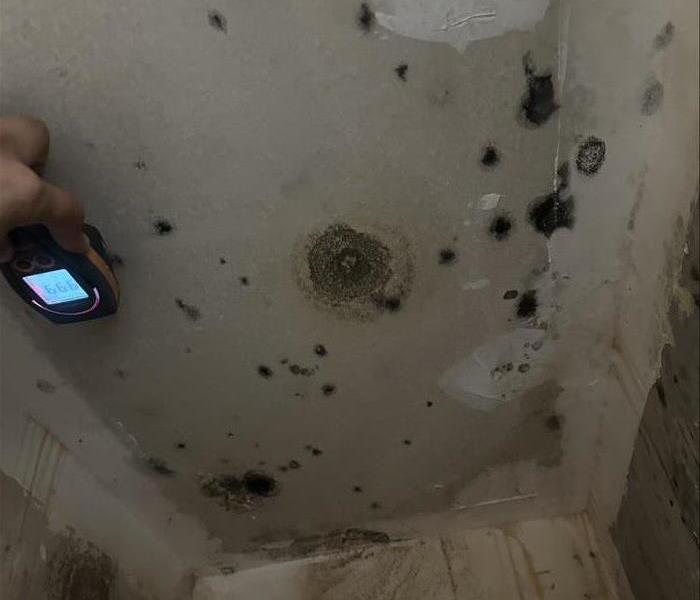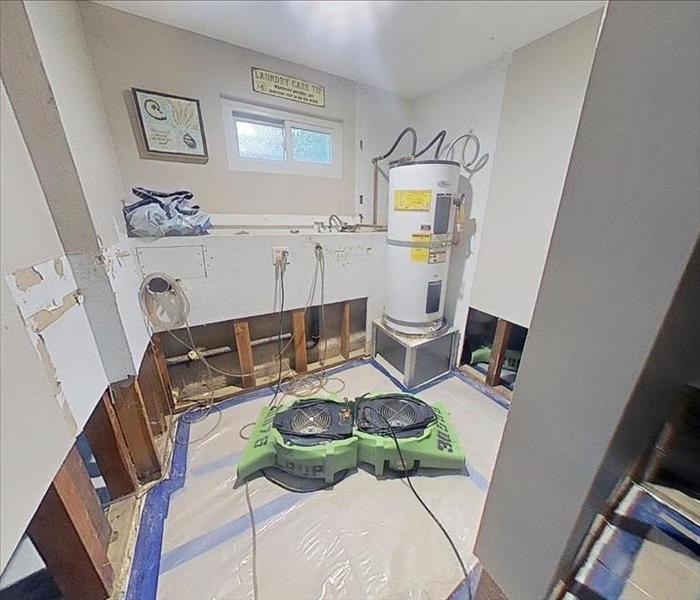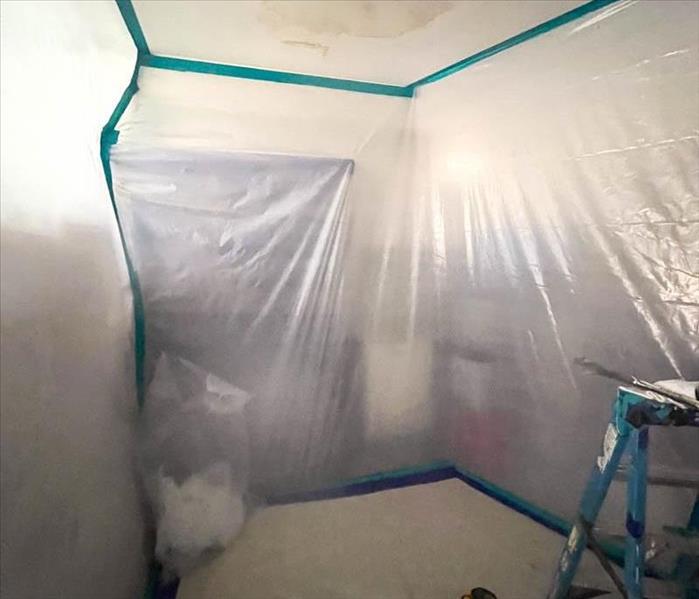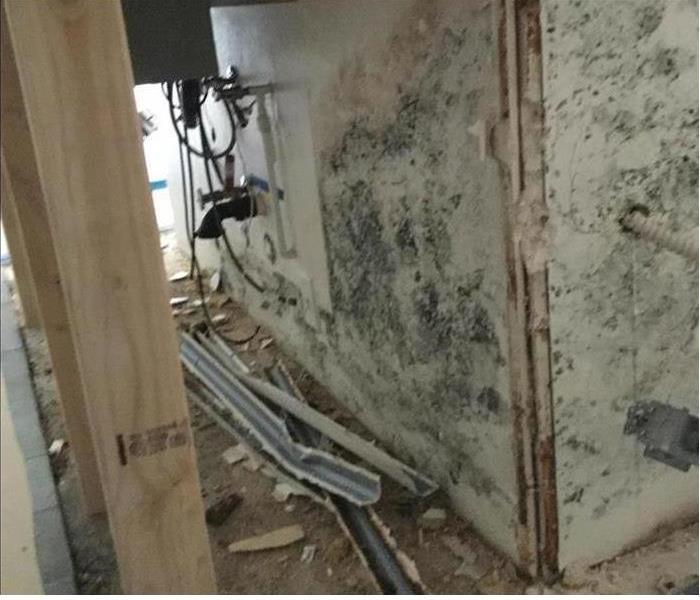Recent Mold Remediation Posts
Say Goodbye to Mold: How to Keep Your HVAC Ducts Clean and Clear
11/9/2024 (Permalink)
 If you need professional help with mold removal or duct cleaning, contact SERVPRO of Costa Mesa today.
If you need professional help with mold removal or duct cleaning, contact SERVPRO of Costa Mesa today.
Mold growing in your HVAC ducts can be a real problem, but it’s not always easy to spot. When mold takes hold in your system, it can affect your home's comfort and even the efficiency of your HVAC unit. At SERVPRO of Costa Mesa, we have the expertise to deal with mold in HVAC ducts and prevent future issues. In this blog, we’ll break down why mold shows up in HVAC systems, what you can do about it, and how to stop it from happening again.
What Causes Mold in HVAC Ducts?
Mold needs moisture and a food source to grow, and unfortunately, HVAC systems can sometimes provide the perfect conditions. Here are the main causes:
1. High Humidity: When indoor humidity levels rise, the excess moisture can lead to mold. To reduce the risk, keep your indoor humidity levels between 30% and 50%.
2. Condensation: Cool air passing through HVAC coils can cause condensation to form. If that moisture isn't properly drained, it can collect in your ducts, creating an ideal mold environment.
3. Dust and Dirt: Mold needs organic material to grow, and dust and dirt are perfect for that. When debris builds up in your system, it gives mold the nutrients it needs to thrive.
4. Poor Airflow: If your HVAC system doesn’t have good airflow or is blocked by dust and debris, it can cause moisture to build up in your ducts, which leads to mold growth.
5. Leaky Ducts: Leaky ducts can allow moist air into your system. That added moisture is just what mold needs to grow, so it’s important to seal leaks and keep the system airtight.
Tips for Preventing Mold in Your HVAC System
Once you’ve addressed the mold problem, it’s important to take steps to make sure it doesn’t come back. Here are some prevention tips:
- Regular maintenance: Have your system cleaned and inspected regularly.
- Control humidity: Use a dehumidifier to keep moisture levels low.
- Replace air filters often: Clean filters help keep dust and mold spores out of the system.
- Ensure good airflow: Make sure vents and ducts are open and unblocked.
- Seal leaks: Keep ducts sealed to prevent moisture from entering.
- Fix Condensation Issues: Clear blocked drain lines, repair any leaks, and make sure your system is draining properly to prevent moisture buildup.
- Replace Moldy Ducts: In cases of severe mold infestation, you might need to replace parts of your duct system.
Why Choose SERVPRO®?
Mold in HVAC ducts can be an invisible problem, but it’s one that can be managed with the right steps. By understanding the causes and taking action to clean and maintain your system, you can keep your home comfortable and mold-free. If you need professional help with mold removal or duct cleaning, contact SERVPRO of Costa Mesa today. We’re Here to Help® keep your HVAC system clean and efficient!
The SERVPRO Mold Remediation Process: Step by Step
3/13/2024 (Permalink)
 Our expert team is here to guide you through the SERVPRO Mold Remediation Process, ensuring a thorough and effective solution to your mold issues.
Our expert team is here to guide you through the SERVPRO Mold Remediation Process, ensuring a thorough and effective solution to your mold issues.
At SERVPRO®, we understand the stress and concern that mold growth can bring to homeowners and business owners alike. Mold not only poses a threat to the structural integrity of your property but also to your personal belongings. That's why our expert team is here to guide you through the SERVPRO Mold Remediation Process, ensuring a thorough and effective solution to your mold issues.
Step 1: Inspection and Assessment
The first crucial step in our mold remediation process is a comprehensive inspection and assessment of your property. Our certified professionals use state-of-the-art technology to identify the extent of the mold infestation and the moisture sources that fuel its growth. This step is vital for developing a tailored remediation plan.
Step 2: Containment
Once the mold-affected areas are identified, our team employs advanced containment techniques to prevent the spread of mold spores to uncontaminated areas. This includes the use of barriers and negative air pressure to isolate the affected space, safeguarding the rest of your property.
Step 3: Filtration
To further ensure the containment of mold spores, SERVPRO utilizes powerful air filtration equipment equipped with High-Efficiency Particulate Air (HEPA) filters. These filters trap microscopic particles, preventing the recurrence of mold growth and maintaining a mold neutral indoor environment.
Step 4: Removal of Mold-Infested Materials
Our team proceeds to remove and dispose of materials contaminated with mold. This may include drywall, carpeting, and other porous items that cannot be effectively cleaned. This step is essential to eliminate the source of mold and prevent its recurrence.
Step 5: Cleaning and Sanitization
Once the mold-infested materials are removed, the affected surfaces are thoroughly cleaned and sanitized using industry-approved antimicrobial treatments. This ensures the elimination of any remaining mold spores and prevents the development of new colonies.
Step 6: Restoration
After completing the remediation process, our focus shifts to restoring your property to its pre-mold condition. This may involve minor repairs, such as replacing drywall or flooring, to bring your home or business back to a safe and comfortable state.
At SERVPRO, our mold remediation process is designed to provide comprehensive and effective solutions tailored to your specific needs. By following these step-by-step procedures, our expert team ensures that your property is not only free from mold but also restored to its original state. Trust SERVPRO for a seamless and thorough mold remediation experience, bringing peace of mind to property owners facing mold challenges.
What You Need to Know About Selling a House With Mold
11/14/2023 (Permalink)
 Mold issues can be a significant roadblock when selling a house.
Mold issues can be a significant roadblock when selling a house.
Today, we'll delve into a topic that many homeowners might face: selling a house with mold issues. Costa Mesa's beautiful coastal location comes with its share of moisture challenges, and understanding how to navigate mold concerns during the sale process is crucial. In this blog, we'll provide you with the knowledge you need to make informed decisions when selling a property that may have a mold problem.
Understanding the Impact of Mold on the Sale of Your House
Mold issues can be a significant roadblock when selling a house. Potential buyers may be wary of purchasing a property with mold, and lenders may hesitate to approve loans for homes with mold-related concerns. To successfully sell your house, it's essential to be well-informed about mold's impact on the sale process.
Property Value
Mold problems can negatively affect your property's value. Potential buyers may seek a reduced price to accommodate the cost of mold remediation, or they may simply walk away from the deal.
Disclosure Requirements
In California, sellers are legally obligated to disclose any known mold problems. Failing to do so can lead to legal and financial consequences down the road.
Inspections and Buyer Concerns
Buyers often request mold inspections. If mold is discovered, it can raise concerns, potentially leading to delays or even the termination of the sale.
Lender Approval
Lenders may hesitate to approve loans for homes with known mold issues, making it challenging for buyers to secure financing.
Dealing With Mold Issues When Selling a House
Before listing your property, consider hiring a professional mold inspector to identify the extent of the problem. Understanding the severity of the mold issue is the first step in addressing it. If mold is present, it's typically best to address the problem before listing the property. Mold remediation by certified professionals can help ensure the issue is properly resolved.
Fulfill your legal obligation by disclosing any known mold problems to potential buyers. Honesty is essential in the real estate market. When disclosing mold problems, it's helpful to offer solutions, such as proof of mold remediation and any preventative measures you've taken.
Selling a house with mold concerns requires careful planning, transparency, and effective resolution of the issue. Mold problems can impact the sale, but with the right approach, you can successfully navigate this challenge. SERVPRO® of Costa Mesa is here to assist with any mold-related situation, from inspection to remediation. For more information or to schedule an inspection, contact us today and ensure a seamless sale of your property.
Black Mold 101: Understanding its Appearance, Growth, and Prevention
5/17/2023 (Permalink)
Black mold is a type of fungus that can grow in areas that are damp, humid, and poorly ventilated. It is often found in homes and buildings with water damage or leaks, and it can cause structural damage if left unchecked.
The Appearance of Black Mold
Black mold has a distinctive appearance that sets it apart from other types of mold. It is usually black or dark green in color and has a slimy texture. It can grow in clusters that can be seen with the naked eye, and it can also produce spores that can spread to other areas of the building.
The Growth of Black Mold
Black mold can grow in a variety of environments, but it thrives in damp and humid conditions. It often grows in areas with water damage, such as basements, crawl spaces, and bathrooms. It can also grow on materials that retain moisture, such as drywall, carpeting, and ceiling tiles.
The Dangers of Black Mold
While black mold is not inherently dangerous, it can cause structural damage if left unchecked. It can weaken and break down materials such as wood and drywall, leading to costly repairs. Additionally, black mold can be a sign of underlying moisture problems in the building, which can lead to further damage and mold growth.
Preventing Black Mold
Preventing black mold is important in order to avoid the potential costs and dangers associated with its growth. Here are some tips for preventing black mold:
Fix leaks promptly: Any leaks in the building should be fixed as soon as possible to prevent water damage and mold growth.
Maintain proper ventilation: Ensuring that there is adequate ventilation in the building can help to prevent moisture buildup and mold growth.
Keep humidity levels low: Humidity levels should be kept below 60% to prevent mold growth.
Use mold-resistant materials: When renovating or building, it is important to use mold-resistant materials such as mold-resistant drywall and paint.
Regular cleaning: Regular cleaning can help to prevent mold growth by removing any moisture and keeping surfaces dry.
Black mold is a type of fungus that can grow in damp, humid, and poorly ventilated areas. While it is not inherently dangerous, it can cause structural damage if left unchecked. Preventing black mold is important in order to avoid potential costs and dangers associated with its growth. By fixing leaks promptly, maintaining proper ventilation, keeping humidity levels low, using mold-resistant materials, and regularly cleaning, you can help prevent black mold from growing in your home or building.
Reasons You Could Be Sued for Mold Growth
3/7/2022 (Permalink)
 Mold infestations cause a lot of damage and can be very expensive to remediate. Call SERVPRO as quickly as possible when noticing signs of mold damage
Mold infestations cause a lot of damage and can be very expensive to remediate. Call SERVPRO as quickly as possible when noticing signs of mold damage
Reasons You Might Be Sued Due to Mold Growth
if you are a building owner in Downtown Costa Mesa, CA, you could be sued for the detrimental impact of mold on your property. This is true if you lease buildings to an industrial client or to an office customer, but it is perhaps most commonly seen in regards to apartment complexes. People who use your building space or who rent rooms expect a clean and healthy environment in which to live or conduct business.
The presence of mold colonies makes a site unpleasant and could even impact air quality in the space. This could result in mold insurance claims that seek liability damages.
How To Avoid a Mold Claim
While the situation could seem fraught with difficulty, it is easy to overcomplicate things. You have a few basic responsibilities when it comes to maintaining your property for a client:
- Keep the building in good shape
- Respond to complaints in a timely manner
- Fix items that are broken
- Make sure your clients are safe
If you take care of these items, you will likely prevent lawsuits against your company. While mold is a challenging problem for any company, you have a number of opportunities to limit your exposure to mold insurance claims. Preventative measures such as cleaning up water leaks can stop mold growth from becoming a problem.
How To Handle Mold Remediation
If a client does complain about mold colonies in your building, you should call for the services of a professional mold mitigation company. Trained technicians will come to your property and work efficiently to contain and then remove mold. They will use advanced equipment and proven cleaning agents to make sure the mold is gone from all areas of your building. A professional cleaning job makes sure that mold will not return in the near future. This is the best way to reassure your customers that the mold is gone and to prevent any mold insurance claims.






 24/7 Emergency Service
24/7 Emergency Service


